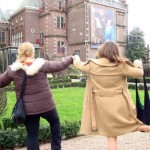Art: A Two-Way Street in London’s National Gallery

There is a strict “no camera” policy at London’s National Gallery, so while I don’t have any pictures of this adventure, I was fortunate enough to get my picture snapped at the top of the steps by a fellow lady traveler! (My favorite icebreaker with other solo travelers has always been the “would you like me to take your picture” swap!) You can also see Trafalgar Square and Big Ben behind me.
The Gallery itself is a work of art. I continue to be taken aback by the beauty of these centuries-old structures.
The Gallery itself is a work of art. I continue to be taken aback by the beauty of these centuries-old structures. You don’t realize how truly young of a country America is until you climb the steps of a building, like the National Gallery, that has been standing in the same place since the 1830s. Where I am from, all of the buildings have been created within the past fifty years, and many of them within the last ten.
I can tell you when things have been built and what grade I was in at the time. It’s a huge difference from reading about it in a history book. I am amazed by the integrity of these buildings, and the revolutionary minds that designed and built them.
Located in Trafalgar Square, the National Gallery is literally in the center of the city. The minds behind the gallery felt that it was important for London’s citizens to have the opportunity to visit and appreciate amazing works of art free of charge. They believed that children should always be welcomed, and that both the richest and poorest citizens should have equal opportunity to visit.
The gallery is arranged so that you can travel through time and across the region from collection to collection.
At the time, western London was home to the wealthy and the east was where the poorer citizens lived. With a location equidistant to both, the National Gallery was accessible to all. To this day, admission to the National Gallery is free of charge. Children continue to be welcomed, and their interest in the works is encouraged.
London’s National Gallery houses one of the largest and most impressive collections of Western European paintings. The gallery is arranged so that you can travel through time and across the region from collection to collection. There is an entire Claude-Oscar Monet collection with many of his most recognizable landscapes. I was most interested in his “The Thames below Westminster” from 1871, which features a look at the Big Ben and the Houses of Parliament.
Art: A Two-Way Street in London’s National Gallery
There is also a selection of Van Gogh pieces, namely “Sunflowers.” It was interesting to see people crowding about this one piece of the hundreds in the gallery. That piece is something even the untrained eye recognizes, and there it was, just hanging on the wall.
I spent a good hour to ninety minutes in the gallery. I don’t remember every piece, and I don’t remember every artist’s name. But, I continued to be captivated by the idea of art, and how it does so many things for us as people. Whether it’s a canvas and brush or a melody, this idea of creation survives us all. Some of these paintings stretched as far back as the 13th century. And here we are, in 2010, looking at the very same pieces.
All of these little details were for the sake of the art.
I was floored by the amount of work that goes into the function of the gallery that houses these pieces. The lighting, the infrastructure, the temperature of the room, the security – all of these were catered to the preservation and celebration of these works of art. The framing that encompassed these works was also incredible. Some of these pieces were bigger than life-size, taking up an entire wall, and around each piece was a frame, appropriate to the scale and style of the work.
If you looked closely, you could see the reinforcement used to support these larger pieces. The rooms were arranged to catch your eye in a particular order. Some pieces were arranged so that they could be easily compared, while others were arranged to better translate the artist’s message. All of these little details were for the sake of the art. It was as if the gallery was making the effort to give the art what it continues to give us – nourishment.








